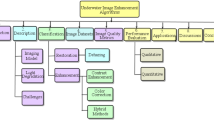Abstract
The physical transformation of light will cause the quality of underwater images to decrease, which impacts the precision of object detection, recognition, and segmentation in underwater circumstances. In this study, we suggest an underwater image enhancement combining low-dimensional and global features (UIELG). This model can availably heighten the texture minutiae and global key features of subaquatic images. Moreover, we advise a new loss function, which can effectively boost the structure and texture similarity of underwater images. Finally, we train and test the model on the synthetic subaquatic images. The experimental outcomes declare that this model is preferable to the existing models in both SSIM and PSNR scores. And the experimental outcomes on the real-world subaquatic image dataset present the generalization and robustness of the suggested model.











Similar content being viewed by others
Data availability
All authors make sure that all data and materials as well as software application.
Code availability
Custom code support their published claims and comply with field standards.
References
Ashish, K.B., et al.: A novel fuzzy clustering based histogram model for image contrast enhancement. IEEE T. Fuzzy. Syst. 28, 2009–2021 (2019)
Wei, S., et al.: Enhancement of underwater images with statistical model of background light and optimization of transmission map. IEEE Trans. Broadcast. 66, 153–169 (2020)
Derya, A., Tali, T.: Sea-thru: a method for removing water from underwater images. In: Proceedings of the IEEE/CVF Conference on Computer Vision and Pattern Recognition (2019)
Ho, S.L., et al.: underwater image enhancement using successive color correction and superpixel dark channel prior. Symmetry. 12, 1220 (2020)
Jie, L., et al.: WaterGAN: unsupervised generative network to enable real-time color correction of monocular underwater images. IEEE Robot. Autom. Let. 99 (2017)
Pritish, U., et al.: All-in-one underwater image enhancement using domain-adversarial learning. In: Proceedings of the IEEE/CVF Conference on Computer Vision and Pattern Recognition Workshops. pp. 1–8 (2019)
Chongyi, L., et al.: Underwater scene prior inspired deep underwater image and video enhancement. Pattern Recognit. 98 (2020)
Md, J.I., et al.: Fast underwater image enhancement for improved visual perception. IEEE Robot. Autom. Lett. 5, 3227–3234 (2020)
Songtao, L., et al.: Receptive field block net for accurate and fast object detection. In: European Conference on Computer Vision, pp. 404–419 (2018)
John, Y.C., Yingching, C.: Underwater image enhancement by wavelength compensation and dehazing. IEEE Trans. Image Process. 21, 1756–1769 (2012)
Olaf, R., et al.: U-Net: convolutional networks for biomedical image segmentation. In: Medical Image Computing and Computer Assisted Intervention Society. pp. 3–3 (2015)
Sanghyun, W., et al.: CBAM: convolutional block attention module. In: European Conference on Computer Vision. pp. 3–19 (2018)
Jie, H., et al.: Squeeze-and-excitation networks. In: Proceedings of the IEEE/CVF Conference on Computer Vision and Pattern Recognition (2018)
Forrest, N. L., et al.: DenseNet: implementing efficient convNet descriptor pyramids. Journal. arXiv:1404.1869 (2014)
Hang, Z., et al.: Loss functions for image restoration with neural networks. IEEE Trans. Comput. Imaging. 3, 47–57 (2017)
A. Galdran, A., et al.: Automatic red-channel underwater image restoration. Vis. Commun. Image. Rep. 26, 132-145 (2015)
Paulo, L. J. D. J., E. et al.: Underwater depth estimation and image restoration based on single images. IEEE Comput. Graph. Appl. 36, 24–35 (2016)
Chongyi, L., et al.: Underwater image enhancement by dehazing with minimum information loss and histogram distribution prior. IEEE Trans. Image Process. 25, 5664–5677 (2016)
Yan, T.P., Pamela, C.C.: Underwater image restoration based on image blurriness and light absorption. IEEE Trans. Image Process. 26, 1579–1594 (2017)
Nathan, S., et al.: Indoor segmentation and support inference from rgbd images. In: European Conference on Computer Vision (2012)
Jerlov, N. G.: Marine Optics. Elsevier (1976)
Chongyi, L., et al.: An underwater image enhancement benchmark dataset and beyond. IEEE Trans. Image Process (2019)
Fu, X., Cao, X.: Underwater image enhancement with global-local networks and compressed-histogram equalization. Signal Process Image Commun. 86 (2020)
Yang, H.H., et al.: Laffnet: A lightweight adaptive feature fusion network for underwater image enhancement. Journal. arXiv:2105.01299 (2021)
Danya, Z., et al.: Single-image super-resolution based on local biquadratic spline with edge constraints and adaptive optimization in transform domain. Vis. Comput. (2020)
Jiawan, Z., et al.: Local albedo-insensitive single image dehazing. Vis. Comput. 26, 761–768 (2010)
Acknowledgements
There is no financial support for this work. The authors declare that no conflicts of interest exist.
Funding
The authors did not receive support from any organization for the submitted work. No funding was received to assist with the preparation of this manuscript. No funding was received for conducting this study. No funds, grants, or other support was received.
Author information
Authors and Affiliations
Contributions
NQ hereby confirm on behalf of all authors that This manuscript, or a large part of it, has not been published, was not, and is not being submitted to any other journal. All authors each made a significant contribution to the research reported and have read and approved the submitted manuscript.
Corresponding author
Ethics declarations
Conflict of interest
The authors have no relevant financial or non-financial interests to disclose. The authors have no conflicts of interest to declare that are relevant to the content of this article. All authors certify that they have no affiliations with or involvement in any organization or entity with any financial interest or non-financial interest in the subject matter or materials discussed in this manuscript. The authors have no financial or proprietary interests in any material discussed in this article.
Ethical approval
All authors approvals.
Consent to participate
All authors consent to participate.
Consent for publication
All authors consent to publication.
Additional information
Publisher's Note
Springer Nature remains neutral with regard to jurisdictional claims in published maps and institutional affiliations.
Rights and permissions
About this article
Cite this article
Qiao, N., Di, L. Underwater image enhancement combining low-dimensional and global features. Vis Comput 39, 3029–3039 (2023). https://doi.org/10.1007/s00371-022-02510-5
Accepted:
Published:
Issue Date:
DOI: https://doi.org/10.1007/s00371-022-02510-5




